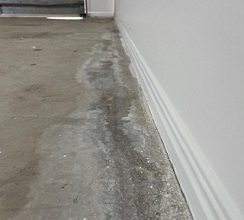Slab Edge Dampness and Salt Deposits: A Common Building Defect
Slab edge dampness and salt deposits are a common problem in many buildings. This is often picked up in a pre-purchase Building and Pest Inspection. It can lead to serious damage if left unchecked. In this post, we’ll explore what causes slab edge dampness and salt deposits, the signs to look out for, and how to prevent and fix the issue.
1: What is Slab Edge Dampness?
Slab edge dampness occurs when moisture from the ground comes into contact with the concrete slab and wicks up the edges of the slab. This can happen due to a variety of factors, including poor drainage, high water tables, or inadequate waterproofing.
2: What are Salt Deposits?
Salt deposits are the result of the evaporation of moisture containing dissolved salts. When this moisture reaches the surface, it evaporates, leaving behind salt deposits. In buildings, salt deposits are often found in areas affected by dampness, such as walls and floors.
3: The Impact of Slab Edge Dampness and Salt Deposits
If left unchecked, slab edge dampness and salt deposits can cause serious damage to buildings. The moisture can lead to mold growth, damage to structural components, and create an ideal environment for termite infestation. The salts can also cause damage to building materials, such as concrete, brick, and plaster.
4: Signs of Slab Edge Dampness and Salt Deposits
Some signs that may indicate slab edge dampness and salt deposits include:
- Discoloration or staining on walls or floors
- Peeling paint or wallpaper
- Crumbling plaster or brickwork
- Musty or damp odors
- Efflorescence (white powder or crystals) on walls or floors
5: Prevention and Fixing Slab Edge Dampness and Salt Deposits
Preventing and fixing slab edge dampness and salt deposits requires identifying the root cause and taking appropriate measures to address it. Some possible solutions include improving drainage, installing a vapor barrier, and sealing cracks and gaps in the foundation. It’s also important to address any existing damage caused by the dampness and salts, such as replacing damaged materials and repairing structural components.
Conclusion:
Slab edge dampness and salt deposits are common building defects that can cause serious damage if left unchecked. By understanding the causes, signs, and solutions to these issues, building owners can take steps to prevent and fix them before they cause significant damage. If you suspect slab edge dampness or salt deposits in your building, it’s important to seek the help of Premier Building and Pest Reports who can assess the situation and recommend appropriate measures to address the problem.

